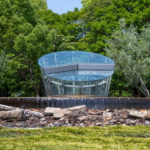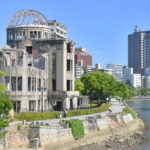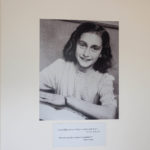With His Experience of the Atomic Bomb as a Starting Point, He Paints His Wishes for Salvation Hirayama Ikuo, “The Holocaust of Hiroshima”

Hirayama Ikuo, “The Holocaust of Hiroshima” (1979) Hiroshima Prefectural Art Museum Collection
The streets of Hiroshima burn bright red and the Buddhist deity Acala looks down from above. When viewing a photograph of “The Holocaust of Hiroshima” (1979, Hiroshima Prefectural Art Museum Collection) by Hirayama Ikuo, a painter from Hiroshima, many people may have the impression that it is a gruesome work. But if you stand in front of the work itself, you’ll receive a different impression, says Jinnai Yuri, head curator at the Hiroshima Prefectural Art Museum.
“‘The Holocaust of Hiroshima’ is a large work at 3m64cm wide and 1m71cm high, but the majority of the canvas is filled in with flames of red. However, there is gold dust finely incorporated in the depiction of fire, which appears to be heading towards Acala. Speaking of Acala, he is known for his rageful countenance, but in this work, he impresses you with an expression that holds a deep sadness amidst the rage. The gold fire dust heading for Acala may represent the souls of people, bearing the meaning of a repose of souls.”

Mr. Hirayama Ikuo, Hiroshima-born painter (1930-2009)
Hirayama was born and raised on Ikuchi Island, and attended Shudo Middle School in Hiroshima City. In his third year of middle school, he was exposed to the radioactive blast of the atomic bomb while in the midst of physical labor. By chance he witnessed the white parachute dropped by the B-29, and entered a hut in order to tell a friend; because of this, he says he was miraculously saved. “The Holocaust of Hiroshima” is the sole large-scale work Hirayama created, 34 years after the end of the war.
Hirayama left the following words in his writings:
“‘That day’ I lived. I survived. That’s something to be grateful for. But for me, I wonder if it was a conclusive sin that I bore, something I must atone for.” (Hirayama Ikuo, In the Flow of Eternity, 1993)
“The Holocaust of Hiroshima” is a work which Hirayama, as a survivor of the atomic bomb, was finally able to paint after continual questioning of the meaning of his life. “Hirayama himself may have sought relief in this work,” says Jinnai.
“If I have a chance to depict the atomic bombing, it wouldn’t be as an artist; I’ve come to believe it would be when I am able to depict it as someone who lived that day of the atomic bomb, as a person who lost a great many friends on the day of the atomic bomb. That painting would have to be one which beseeches atonement and salvation for the dead and myself, and for the people of the same generation who created this weapon of insanity.” (Hirayama Ikuo, Towards the Aquamarine Sea- Music for My Youth, 1988)
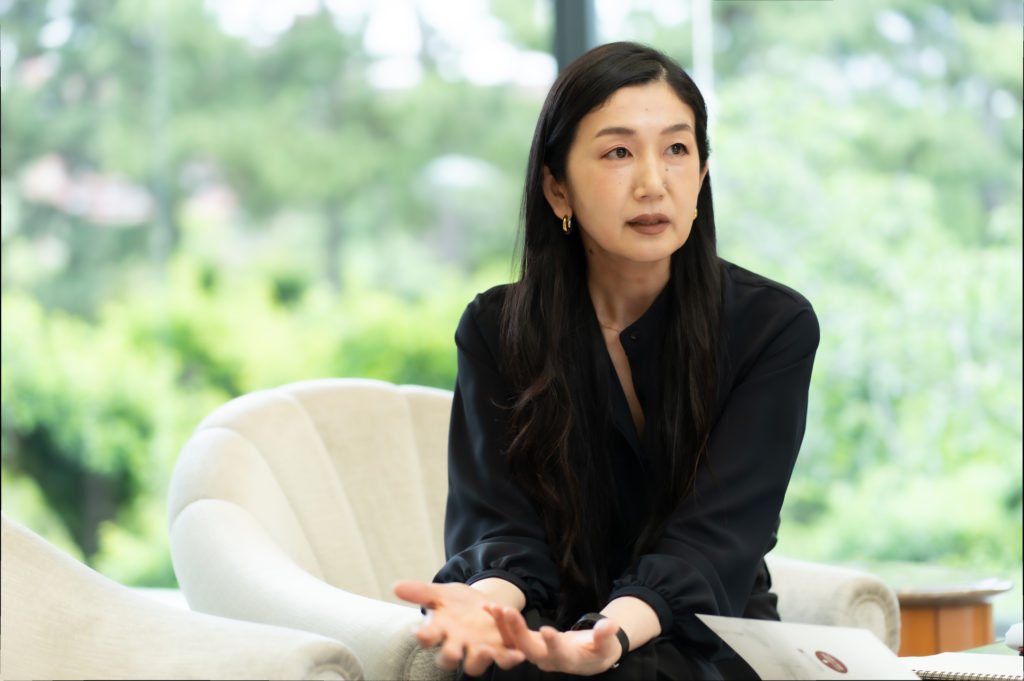
Ms. Jinnai Yuri, Chief Curator of the Hiroshima Prefectural Art Museum
After the atomic bombing, Hirayama transferred schools, lodging at the home of his granduncle, the engraver Shimizu Nanzan, while attending middle school in Takehara City. Afterwards, he said that he avoided stepping into Hiroshima City for many decades. When he painted “The Holocaust of Hiroshima,” there was a plan to go to the Peace Memorial Park as part of a TV program. The moment he saw the flames of the lights for peace, the picture swelled up in his mind, and he says he worked out the idea on the return bullet train to Tokyo.
“Hirayama wrote that not just ‘The Holocaust of Hiroshima’ but his art itself was ‘a memorial service for the people who died in the war,’” says Jinnai.
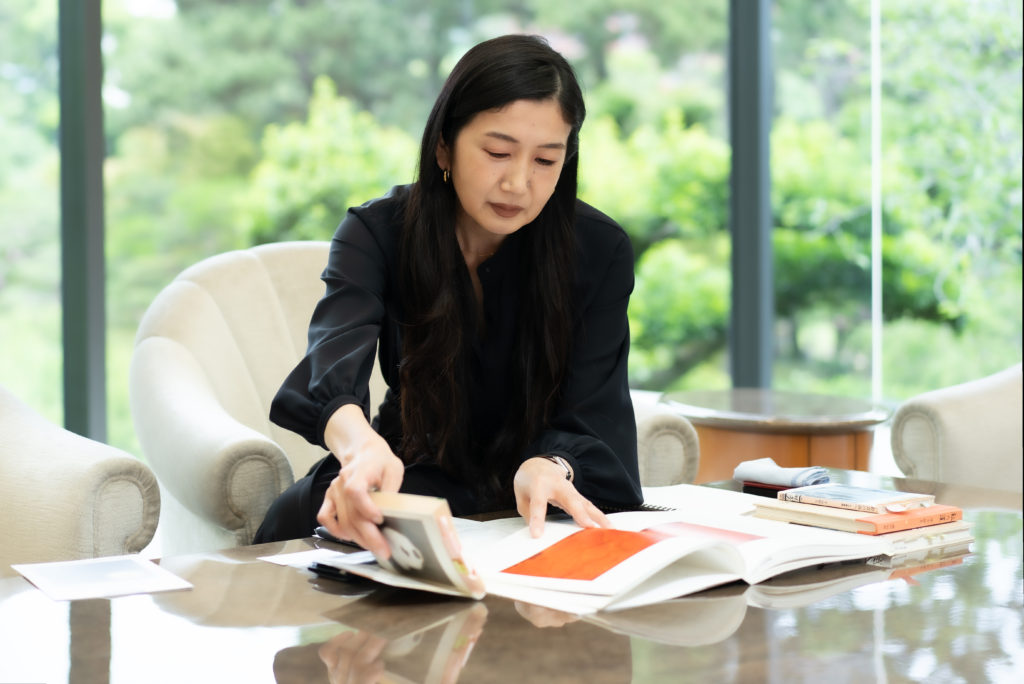
On Nanzan’s recommendation he went to Tokyo Fine Arts School (modern-day Tokyo University of the Arts), entering the department of Japanese painting. When he began working as a painter at the age of 28, Hirayama discovered that he suffered from after-effects of the atomic bomb: he had only half the white blood count of a typical person. Frightened by the shadow of death, a despairing Hirayama said, “I want to paint one work which remains in the heart before I die,” and painted “Introduction of Buddhism” (1959, Saku Municipal Museum of Modern Art Collection), which depicts the return journey of the Buddhist monk Xuanzang as he brought the sutras to China from India.
After that, he came to paint Buddhist themes, and before long deepened his interest in the Silk Road. He spent the approximately forty years right up to his death visiting various places on the Silk Road and painting them in works. In later years he actively painted Japan’s shrines and temples, such as Hiroshima’s Itsukushima Shrine, and rediscovered the beauty of Japan as the last stop on the Silk Road.
From his childhood gazing across the Seto Inland Sea, experiencing the atomic bombing, and going between the Silk Road and Japan and comparing them, he looked hard at the beauty unique to Japan. Depicting the Silk Road in Japanese paintings in a time when that was new, and continually producing distinctive works from his heightened perspective, Hirayama’s life and art both trace their origins to a desire for peace.
The Hiroshima Prefectural Art Museum exhibits Hirayama Ikuo’s “The Holocaust of Hiroshima.” In addition, inside the building’s welcome gallery, you can see the Prefectural Art Museum’s collection of Hirayama’s works.
“We would love for as many people as possible to see works that connect to thoughts for peace in Hiroshima,” says Jinnai.

Hiroshima Prefectural Art Museum
Telephone: 082-221-6246
Address: 2-22, Kaminobori-Cho, Naka-Ku, Hiroshima City
Hours: 9:00-17:00 (last entrance 30min before closing)
Open until 8pm on Fridays from April 1-September 24, 2023
Open until 7pm on Fridays from September 25- March 31
Closed: Mondays, year end (12/25-1/1)
*Excluding holidays and substitute holidays. May be open without normal closure for special exhibitions
Website: https://www.hpam.jp/museum/
【Exhibition of Museum’s Collections】
Second Term: Summer Museum
Magical Hiroshima Prefectural Art Museum/Planned in Collaboration with Shukkeien Garden
July 6 (Thu) – September 10 (Sun)
*”The Holocaust of Hiroshima” is planned to be exhibited during the above period.
Tags associated with this article




